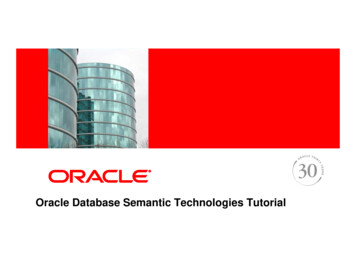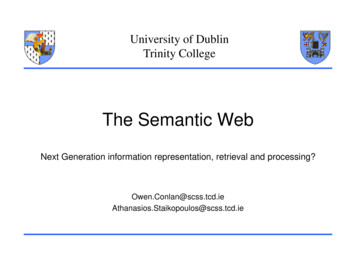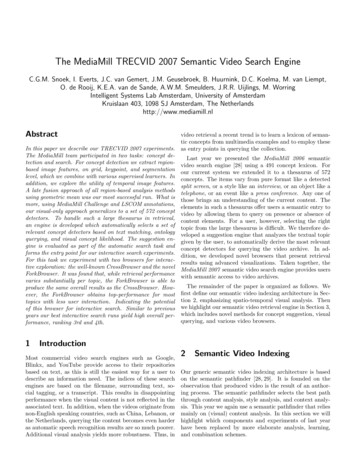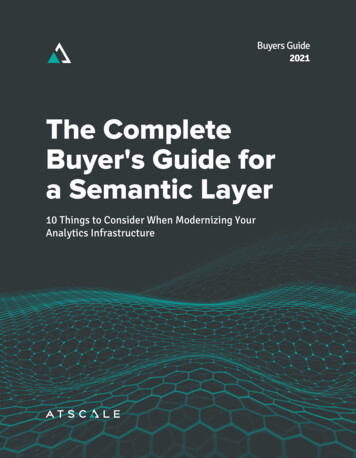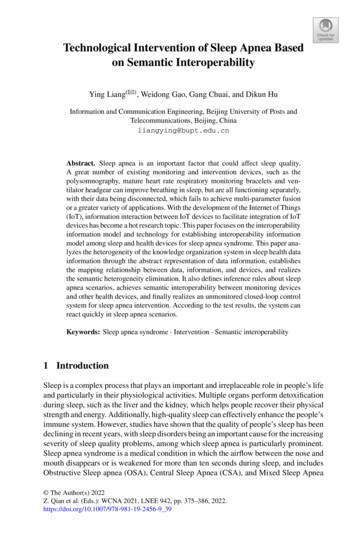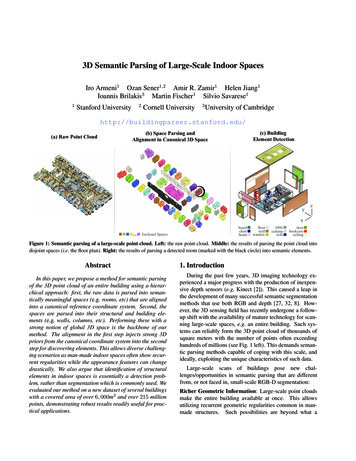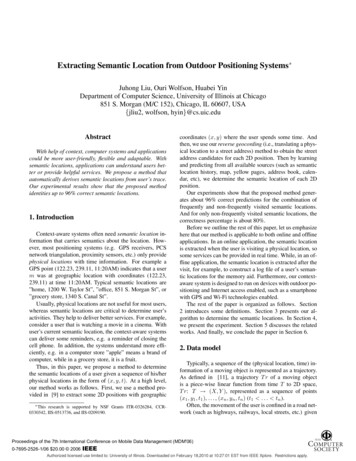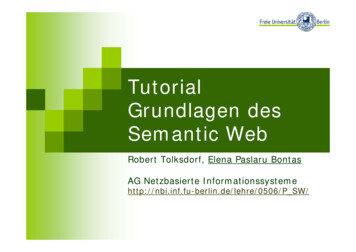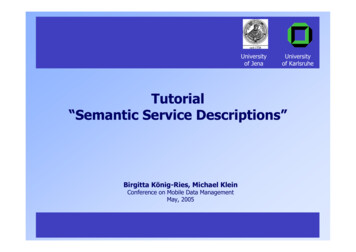
Transcription
Universityof JenaUniversityof KarlsruheTutorial“Semantic Service Descriptions”Birgitta König-Ries, Michael KleinConference on Mobile Data ManagementMay, 20051
Universityof JenaUniversityof KarlsruheTutorial“Semantic Service Descriptions”Why should I care aboutsemantic service descriptions?Birgitta König-Ries, Michael KleinConference on Mobile Data ManagementMay, 20052
Vision: “Really Mobile Office”FILEprint check spellingprojectsend to encryptMORE Overcome limited computingcapabilities Overcome missing attacheddevices Overcome missing internetconnections Do operations with yourmobile device as though you satat your desktop PC3 “Semantic Service Descriptions” – Birgitta König-Ries, Michael KleinTutorial3
Vision: “Office” for the Real WorldMOVIEgetInfo reserveSeat buyDVD downloadSoundtrack chatWithMainActor MORE Also affect the real world!4 “Semantic Service Descriptions” – Birgitta König-Ries, Michael KleinTutorial4
Service Oriented ArchitectureNon-Mobile Business ice Oriented MiddlewareNetwork(Internet, Cell-based, Ad-hoc, )ServiceProviderServiceProviderServiceProvider5 “Semantic Service Descriptions” – Birgitta König-Ries, Michael KleinTutorialServiceProviderServiceProvider5
Service Oriented Computing Network not as collection of documents but as acollection of functionality Applications and business processes use functionality of otherentities loosely coupled / reusable components especially interesting: in mobile networks with limited capabilities in the internet: large companies, many services6 “Semantic Service Descriptions” – Birgitta König-Ries, Michael KleinTutorial6
Characteristics of SOCCharacteristics Functionality is hidden behind an interface Offered functionality is publicly described Service public functionality that can be published,discovered, and executed across the network(client-server paradigm)7 “Semantic Service Descriptions” – Birgitta König-Ries, Michael KleinTutorial7
General Process: the „Service Triangle“8. invoke9. executeRequestor(Client)3. describerequestProvider(Server)10. transfer results6. select7. configure1. describe offer2. publish4. search For5. matchRepository8 “Semantic Service Descriptions” – Birgitta König-Ries, Michael KleinTutorial8
Main Advantages of SOC Dynamic Service Binding „Functionality binding on the fly“ robust context-aware network independent Most important task: automation Complete process should be automatic Important: Service Description Language (and its processing) determines degree of automation9 “Semantic Service Descriptions” – Birgitta König-Ries, Michael KleinTutorial9
Service Description uests?Which provider is appropriate? (matching)How to invoke it? (binding, erviceProviderServiceProviderServiceProvider10 “Semantic Service Descriptions” – Birgitta König-Ries, Michael KleinTutorial10
Service Description LanguageMobileApplicationServiceRequestsGoal: decide automatically!Requires appropriate description languageServiceRequests?Which provider is appropriate? (matching)How to invoke it? (binding, erviceProviderServiceProviderServiceProvider11 “Semantic Service Descriptions” – Birgitta König-Ries, Michael KleinTutorial11
OverviewWhy should I care about semantic service descriptions?What should a semantic service description look like?What is out there? (Part 1: WSDL)What is out there? (Part 2: OWL-S)What is out there? (Part 3: WSMO)What is out there? (Part 4: DSD)What was all this about?12 “Semantic Service Descriptions” – Birgitta König-Ries, Michael KleinTutorial12
OverviewWhy should I care about semantic service descriptions?(10 min)What should a semantic service description look like?(10 min)What is out there? (Part 1: WSDL)(20 min)What is out there? (Part 2: OWL-S)(45 min) Coffee BreakWhat is out there? (Part 3: WSMO)(45 min)What is out there? (Part 4: DSD)(20 min)What was all this about?(20 min)13 “Semantic Service Descriptions” – Birgitta König-Ries, Michael KleinTutorial13
OverviewWhy should I care about semantic service descriptions?What should a semantic service description look like?What is out there? (Part 1: WSDL)What is out there? (Part 2: OWL-S)What is out there (Part 3: WSMO)What is out there? (Part 4: DSD)What was all this about?14 “Semantic Service Descriptions” – Birgitta König-Ries, Michael KleinTutorial14
Universityof JenaUniversityof KarlsruheTutorial“Semantic Service Descriptions”What should a semantic service descriptionlook like?Birgitta König-Ries, Michael KleinConference on Mobile Data ManagementMay, 200515
Service Description uests?Which provider is appropriate? (matching)How to invoke it? (binding, erviceProviderServiceProviderServiceProvider16 “Semantic Service Descriptions” – Birgitta König-Ries, Michael KleinTutorial16
Service Description uests?Which provider is appropriate? (matching)How to invoke it? (binding, erviceProviderServiceProviderServiceProvider17 “Semantic Service Descriptions” – Birgitta König-Ries, Michael KleinTutorial17
Service Description Language functionality offered, i. e. what changes in the world occur,when the service is executed expected input parameters provided output parameters necessary conditions (prerequisites) for service execution where to find the service which protocol to use . All this in a machine-understandable formServiceDescServiceProvider18 “Semantic Service Descriptions” – Birgitta König-Ries, Michael KleinTutorial18
Service Description uests?Which provider is appropriate? (matching)How to invoke it? (binding, erviceProviderServiceProviderServiceProvider19 “Semantic Service Descriptions” – Birgitta König-Ries, Michael KleinTutorial19
Service Description uests Desired effect of the service Maybe: inputs the requestor is willing to provide Maybe: protocols the requestor can run In machine-understandable form If matching service offers are to be found automatically: precise description, that reflects preferences powerful discovery mechanism (matcher)20 “Semantic Service Descriptions” – Birgitta König-Ries, Michael KleinTutorial20
OverviewWhy should I care about semantic service descriptions?What should a semantic service description look like?What is out there? (Part 1: WSDL)What is out there? (Part 2: OWL-S)What is out there (Part 3: WSMO)What is out there? (Part 4: DSD)What was all this about?21 “Semantic Service Descriptions” – Birgitta König-Ries, Michael KleinTutorial21
Universityof JenaUniversityof KarlsruheTutorial“Semantic Service Descriptions”Part 1: WSDLBirgitta König-Ries, Michael KleinConference on Mobile Data ManagementMay, 200522
Universityof JenaWSDLWeb Service Description LanguageIntroductionBuilding BlocksDiscoveryToolsSummary23Universityof Karlsruhe
Universityof JenaWSDL: Introduction24Universityof Karlsruhe
What is WSDL? WSDL Web Service Description Language Based on XML (syntax, primitive types from XSD) Is standardized by W3C, at the moment version 2.0 Besides WSDL, other languages for service usage: UDDI (registry) SOAP (message exchange protocol)25 “Semantic Service Descriptions” – Birgitta König-Ries, Michael KleinTutorial25
General Process: the „Service Triangle“8. invoke (SOAP)9. executeRequestor(Client)3. describerequestProvider(Server)10. transfer results (SOAP)6. select7. configure1. describe offer (WSDL)2. publish4. search For5. matchRepository(UDDI) automatic prematching based on categories manual matching and selecting static binding26 “Semantic Service Descriptions” – Birgitta König-Ries, Michael KleinTutorial26
History of WSDLNASSL SDL/SCL 2000: Microsoft, IBM and Ariba jointly issue WSDL 1.02001: A dozen companies submit WSDL 1.1 as W3C Note2002: W3C publishes WSDL 1.2 as Working Draft2003: WSDL is separated into three parts: core, messages, bindings2004: WSDL 2.0 (mainly renamings)27 “Semantic Service Descriptions” – Birgitta König-Ries, Michael KleinTutorial27
Universityof JenaWSDL: Building Blocks28Universityof Karlsruhe
WSDL 1.2 Components as UML Diagramservice publiclycallable functionalityABSTRACTmessage collection ofinformation that can beexchanged via networkCONCRETEoperation function thatprocesses an input messageand returns an outputmessage29 “Semantic Service Descriptions” – Birgitta König-Ries, Michael KleinTutorial29
Types defines important datatypes primitive types from XML schema complex types buildable via complexType -Tag types schema targetNamespace "http://example.com/stockquote.xsd"xmlns "http://www.w3.org/2000/10/XMLSchema" element name "TradePriceRequest" complexType all element name "tickerSymbol" type "string"/ /all /complexType /element element name "TradePrice" complexType all element name "price" type "float"/ /all /complexType /element /schema /types 30 “Semantic Service Descriptions” – Birgitta König-Ries, Michael KleinTutorial30
Messages combines types to abstract messagessmallest interchangeable unitsunidirectionalbuilt up from parts message name "GetLastTradePriceInput" part name "body" element "xsd1:TradePriceRequest"/ /message message name "GetLastTradePriceOutput" part name "body" element "xsd1:TradePrice"/ /message 31 “Semantic Service Descriptions” – Birgitta König-Ries, Michael KleinTutorial31
Operation and PortType Operation is abstract functionality that receives an input messages processes it send set an outputand fault messages PortType groupsoperations to interfaces portType name "StockQuotePortType" operation name "GetLastTradePrice" input message "tns:GetLastTradePriceInput"/ output message "tns:GetLastTradePriceOutput"/ /operation /portType 32 “Semantic Service Descriptions” – Birgitta König-Ries, Michael KleinTutorial32
Operation Types One-way operationsinput onlyclientserver Request-Responseinput, then output(default)clientserver Solicit-Responseoutput, then inputclientserver Notificationoutput onlyclientserver33 “Semantic Service Descriptions” – Birgitta König-Ries, Michael KleinTutorial33
Binding Connects abstract PortTypes with concrete PortsDefines concrete message syntaxDefines concrete communication protocol detailsMost important protocol: SOAPSimpler protocols likeHTTP GET/POST possible binding name "StockQuoteBinding„ type "tns:StockQuotePortType" soap:binding style "document"transport "http://schemas.xmlsoap.org/soap/http"/ operation name "GetLastTradePrice" soap:operation soapAction “http://example.com/GetLastTradePrice"/ input soap:body use "literal"/ /input output soap:body use "literal"/ /output /operation /soap:binding /binding 34 “Semantic Service Descriptions” – Birgitta König-Ries, Michael KleinTutorial34
Port and Service Port specifies a concrete address of a binding Service is a collection of such ports service name "StockQuoteService" port name "StockQuotePort" binding "tns:StockQuoteBinding" soap:address location "http://example.com/stockquote"/ /port /service 35 “Semantic Service Descriptions” – Birgitta König-Ries, Michael KleinTutorial35
Components of WSDL 1.2 – SummaryABSTRACTCONCRETE36 “Semantic Service Descriptions” – Birgitta König-Ries, Michael KleinTutorial36
Renamings in WSDL 2.0WSDL 2.0WSDL 1.2PortEndpointPortTypeInterfaceMessagePartno special tag. Directly definedby xs:element and xs:complexTypeno special tag. Directly definedby xs:sequence and xs:element37 “Semantic Service Descriptions” – Birgitta König-Ries, Michael KleinTutorial37
Example for Changes in WSDL 2.0 types xs:schema xmlns:xs e "http:// /schemas/resSvc.xsd“ xs:element name "checkAvailability“ type "tCheckAvailability"/ xs:complexType name "tCheckAvailability" xs:sequence Part xs:element name "checkInDate" type "xs:date"/ xs:element name "checkOutDate" type "xs:date"/ xs:element name "roomType" type "xs:string"/ /xs:sequence /xs:complexType Message xs:element name "checkAvailabilityResponse" type "xs:double"/ xs:element name "invalidDataError" type "xs:string"/ /xs:schema /types 38 “Semantic Service Descriptions” – Birgitta König-Ries, Michael KleinTutorial38
Universityof JenaWSDL: Discovery39Universityof Karlsruhe
Matching Task: Given a service description for a requested service r and aservice description of an offered service o.Question: Is o suitable to fulfill r’s needs? To what degree? Idea: Matcher compares o and r and calculates matching value in [0,1]0.0: o is not suitable at all1.0: o is perfectly suitableintermediate values: o is suitable to the given degree40 “Semantic Service Descriptions” – Birgitta König-Ries, Michael KleinTutorial40
Matching WSDL Descriptions – Approaches(1) Keyword based Search Request r is set of keywords. Matching value is only a hint Manual postprocessing and selection necessary(2) Type based Matchers Check whether input message of request „provides more“information than input message of offer Check whether output message of request „wants less“information than output message of offer „wants less“ each type in the request has to appear in the offer types of the offer have to be a subtype of the desired types in therequest41 “Semantic Service Descriptions” – Birgitta König-Ries, Michael KleinTutorial41
Type based MatcherRequest rir 1 ir nServiceOffer oor 1io 1 or m io koo 1Service oo l For each or i in r:Is there a oo j in o with oo j subtypeof or i For each io i in o:Is there a ir j in r with ir j subtypeof io i42 “Semantic Service Descriptions” – Birgitta König-Ries, Michael KleinTutorial42
Variation of Type Based Matchers Shared Vocabulary for types via an ontology [WSDL-S] [METEOR-S] Fuzzy matching of type labels Similarity matching using WordNet [WS03] Special Request Languages XSRL [PAPY02]43 “Semantic Service Descriptions” – Birgitta König-Ries, Michael KleinTutorial43
Problems with WSDL MatchingMessage oriented service descriptionincomingmessagesoutgoingmessagesService Problems Not really new. Already in IDLs (CORBA, DCOM, EJB), ebXML, No advantage to pure interface description Semantics not clearFunctionality has to be guessed from flow of information What does a service, that requests a String and outputs an Integer? automatic selection difficult Strict message compatibilityIf messages between provider and requestor do not match, the servicecannot be used44 “Semantic Service Descriptions” – Birgitta König-Ries, Michael KleinTutorial44
Universityof JenaWSDL: Tools45Universityof Karlsruhe
Tools for WSDL Integration in Programming Languages Microsoft .NET Sun: Java Web Service Development Pack XML Processing, SOAP Binding, XML Registry Web Services Toolkit (WSTK) von IBMPlugins for Eclipse (WSDL Viewer, WSDL Validator, )SOAP for PerlNuSOAP – SOAP Toolkit for PHP Tools / Server Components for WSDL Axis (SOAP Server)IBM’s WebsphereGraphical WSDL editors like CapeClearWSDL generators (“right-click on method”)WSDL validators 46 “Semantic Service Descriptions” – Birgitta König-Ries, Michael KleinTutorial46
WSDL in Practice – Early Adopters amazon.com “Amazon E-Commerce Service” Everything but really buy: ItemLookup, ItemSearch, SimilarityLookup CartAdd, CartClear, CartCreate, CartGet, CartModify Somewhat sloppy about types Service requestors need to registers first Intended usage: including Amazon in own web sites ebay.com “eBay SOAP API” Offer Items, Place Bids, Search for articles Formerly: eBay SDK google.com47 “Semantic Service Descriptions” – Birgitta König-Ries, Michael KleinTutorial47
WS-*: Language Extension for WSDL WS-AddressingFor uniquely expressing the address of an endpoint in WSDLdescriptions WS-PolicyFor including non-functional requirements/assertions in WSDLdescriptions WS-Resource Framework (WSRF)For describing resources and states on the service provider. WS-Security (WSS)For securing the usage of web services WS-CoordinationFor enhancing WSDL descriptions by protocols to coordinate theactions of several participants. Example: WS-AtomicTransaction48 “Semantic Service Descriptions” – Birgitta König-Ries, Michael KleinTutorial48
Web Service Composition – BPEL4WSsubprovider 1servicerequestorserviceprovidersubprovider 2subprovider 3WSDLBPEL4WS BPEL4WS Business Process Execution Language for Web Services Specification of the Orchestration, i.e. the coordinationbetween main service and its subservice providers. Developed by Microsoft (“XLANG”) and IBM (“WSFL”)49 “Semantic Service Descriptions” – Birgitta König-Ries, Michael KleinTutorial49
Universityof JenaWSDL: Summary50Universityof Karlsruhe
Evaluation of WSDLAdvantages Easy to understand Widely accepted Rich tool support good integration in programming languages many extensions important early adopters upcoming standard for descriptionDisadvantages Low semantics primitive matchers not usable for automatic service selection designed for static service binding51 “Semantic Service Descriptions” – Birgitta König-Ries, Michael KleinTutorial51
Live Demo Using the “Amazon E-Commerce Service”52 “Semantic Service Descriptions” – Birgitta König-Ries, Michael KleinTutorial52
Top 9 of Important Things about WSDL1)2)3)4)5)6)7)8)9)Standardized by W3CBased on XMLUsed together with UDDI and SOAPModular description separating abstract and concrete serviceDescribes Services by the types of their incoming andoutgoing information (“message based”)Many problems due to lack of semanticsSimple matching algorithms manual discoveryWidely accepted, many tools, important early adoptersExtensions by WS-* and BPEL4WS53 “Semantic Service Descriptions” – Birgitta König-Ries, Michael KleinTutorial53
References[METEOR-S]METEOR-S Project, ike Papazoglou and Marco Aiello and Marco Pistore, Jian Yang, Planning for RequestsAgainst Web Services, IEEE CS Data Engineering Bulletin. Special Issue on WebServices, 25(4), 2002, pp. 41-46[WS03]Yigiao Wang, Eleni Stroulia, Semantic Structure Matching for Assessing Web-ServiceSimilarity, Proc. of the First Intl. Conference on Service Oriented Computing, Trento,Italy, December 2003, pp. 194-207[WSDL-S]WSDL-S, 54 “Semantic Service Descriptions” – Birgitta König-Ries, Michael KleinTutorial54
OverviewWhy should I care about semantic service descriptions?What should a semantic service description look like?What is out there? (Part 1: WSDL)What is out there? (Part 2: OWL-S)What is out there (Part 3: WSMO)What is out there? (Part 4: DSD)What was all this about?55 “Semantic Service Descriptions” – Birgitta König-Ries, Michael KleinTutorial55
Universityof JenaUniversityof KarlsruheTutorial“Semantic Service Descriptions”Part 2: OWL-SBirgitta König-Ries, Michael KleinConference on Mobile Data ManagementMay, 200556
Universityof JenaOWL-SWeb Ontology Language – ServicesIntroductionBuilding BlocksDiscoveryToolsSummary57Universityof Karlsruhe
Universityof JenaOWL-S: Introduction58Universityof Karlsruhe
Who is OWL-S? Maintained by a (rather closed) coalition Burstein (BBN)Sycara, Paolucci (CMU)Hobbs (ISI)Lassila (Nokia)Martin (SRI)McIlraith (Stanford)Payne (U of Southhampton)Parsia (U of Maryland)McDermott (Yale University) Formerly: DAML-S Founded by DARPA (Defense Advanced Research ProjectsAgency) since August 2000 Since November 2004 as OWL-S 1.1 Submitted to W3C for standardization59 “Semantic Service Descriptions” – Birgitta König-Ries, Michael KleinTutorial59
What is OWL-S? OWL-S: OWL-based web service ontology Goal: Develop tools and technology to enable automation ofservices on the semantic web.Main improvements over WSDL Separates semantics from concrete description(approach from the semantic web) Seperate concerns of the description(approach from aspect orientation) Does not only describe message flow(approach from agent community)60 “Semantic Service Descriptions” – Birgitta König-Ries, Michael KleinTutorial60
OWL-S and Ontologies OWL-S includes ideas from theSemantic Web Explicit semantics semantics not interwoven with the description made explicit in additional ontology OWL-S description is an instance of the ontology61 “Semantic Service Descriptions” – Birgitta König-Ries, Michael KleinTutorial61
OWL-S and OWL Therefore: Usage of a Ontology DescriptionLanguage constructs with a well-defined semantics reasoning over concepts is possible equality, subsumption In OWL-S: OWL (Web Ontology Language)OWL-SSWRLOWLDescription LogicsRDF/RDFSXML62 “Semantic Service Descriptions” – Birgitta König-Ries, Michael KleinTutorial62
Ontology in OWLParts: Concepts, properties, individuals (from DL) Concrete domain and values (from XSD) RDF/XML-based syntax (among others) well defined, model-theoretic semantics Compatible with rules fromSemantic Web Rule Language (SWRL)OWL-SSWRLOWLDescription LogicsRDF/RDFSXML63 “Semantic Service Descriptions” – Birgitta König-Ries, Michael KleinTutorial63
Universityof JenaOWL-S: Building BlocksProfileModelGrounding64Universityof Karlsruhe
Upper Ontology of OWL-S Domain independent, upper ontology for services Separation of concerns What does the service do? How do I have to interact? How do I have to invoke it technically? Do not mix what and how as in WSDLTaken from http://www.daml.org/services/owl-s/1.1/overview/65 “Semantic Service Descriptions” – Birgitta König-Ries, Michael KleinTutorial65
Universityof JenaOWL –S Building Blocks: Service Profile66Universityof Karlsruhe
ServiceProfileGoals of the ServiceProfile Describe “what the service does” Enable a service-seeking agent to determine whether theservice meets its needsThe ServiceProfile contains: contact information serviceName, textDescription functional description input/output/precondition/result (IOPRs) references the ServiceModel classification of the service type into a taxonomy e.g. UNSPSC description of non-functional aspects (like QoS)67 “Semantic Service Descriptions” – Birgitta König-Ries, Michael KleinTutorial67
Overview of the ServiceProfileTaken from http://www.daml.org/services/owl-s/1.1/overview/68 “Semantic Service Descriptions” – Birgitta König-Ries, Michael KleinTutorial68
Example for a ServiceProfile: CongoBookBuyContact Information: profile:serviceName Congo BookBuying Agent /profile:serviceName profile:textDescription This agentified service provides the opportunityto browse a book selling site and buy books there /profile:textDescription actor:Actor rdf:ID "CongoBuy contacts" actor:name ExpressCongoBuy /actor:name actor:title Service Representative /actor:title actor:phone 412 268 8780 /actor:phone /actor:Actor 69 “Semantic Service Descriptions” – Birgitta König-Ries, Michael KleinTutorial69
Structure of the functional descriptionnon-functional tOnly pointers to ServiceModel70 “Semantic Service Descriptions” – Birgitta König-Ries, Michael KleinTutorial70
Universityof JenaOWL –S Building Blocks: Service Model71Universityof Karlsruhe
ServiceModelGoal Describes the procedure that is necessary to interact withthe service (from client‘s point of view) Abstract messages only Shows details and processing of IOPEs72 “Semantic Service Descriptions” – Birgitta König-Ries, Michael KleinTutorial72
Process Tranformation Every process represents a transformation Every process has IOPRs Input: the inputs that the process requires Precondition: the conditions that are required for the process torun correctly Outputs: the information that results from (and is returnedfrom) the execution of the process Results: a process may have different outcomes depending onsome condition Condition: under what condition the result occurs Constraints on Outputs Effects: real world changes resulting from the execution of theprocess73 “Semantic Service Descriptions” – Birgitta König-Ries, Michael KleinTutorial73
Details on Parameters input and output are of type Parameter and have aparameterType pointing to a class precondition is logical condition (given in SWRL) e.g. Condition consists of predicate and arguments Predicate is predicate from OWL ontology Argument is instance from service description, typically an input oroutput result consists of inCondition as SWRL-Condition withOutput as Thing hasEffect as SWRL-Expression IOPRs are indirectly interconnected via SWRL-expressions74 “Semantic Service Descriptions” – Birgitta König-Ries, Michael KleinTutorial74
Overview of the ServiceModel – Process ParametersTaken w/75 “Semantic Service Descriptions” – Birgitta König-Ries, Michael KleinTutorial75
OWL-S Example (1)Extract from Congo Book Buy Example (OWL-S 1.1), own graphical sCongoBuy:AtomicProcess76 “Semantic Service Descriptions” – Birgitta König-Ries, Michael KleinTutorial76
OWL-S Example (2)Extract from Congo Book Buy Example (OWL-S 1.1), own graphical edEffect:SWRL-ExpressionbuyOutput:Output resultExpressCongoBuy:AtomicProcess77 “Semantic Service Descriptions” – Birgitta König-Ries, Michael KleinTutorial77
OWL-S Example argument2CongoAcctID : AcctID hasAcctID(SignInInfo, CongoAcctID)78 “Semantic Service Descriptions” – Birgitta König-Ries, Michael KleinTutorial78
Process TypesAtomic Process Execute in a single step (from client‘s point of view) Can be invoked directlyComposite Process Has a state Several messages have to be exchanged between client andserverSimple Process Execute in a single step but cannot be invoked directly element of abstraction79 “Semantic Service Descriptions” – Birgitta König-Ries, Michael KleinTutorial79
Overview of the ServiceModel - ProcessTaken w/80 “Semantic Service Descriptions” – Birgitta König-Ries, Michael KleinTutorial80
Composite Processes Control constructs define the activity that has to be done by theservice requestor to get the specified effect control flow Possible constructs sequencesplitsplit repeat-untilAlso constructs for linking the data flow of different processes very complex81 “Semantic Service Descriptions” – Birgitta König-Ries, Michael KleinTutorial81
Overview of the ServiceModel - CompositeProcessTaken w/82 “Semantic Service Descriptions” – Birgitta König-Ries, Michael KleinTutorial82
The ServiceModel at a GlanceTaken w/83 “Semantic Service Descriptions” – Birgitta König-Ries, Michael KleinTutorial83
Universityof JenaUniversityof KarlsruheOWL –S Building Blocks: Service Grounding84
Service GroundingPurpose: Describes how the service can be accessed technically Technical details on message formatsprotocolsserialization Mapping of the abstract IO in the atomic processes ontoconcrete messages that can be sent over the network85 “Semantic Service Descriptions” – Birgitta König-Ries, Michael KleinTutorial85
Service Grounding using WSDL 1.186 “Semantic Service Descriptions” – Birgitta König-Ries, Michael KleinTutorial86
Mapping of Types OWL and WSDL use the same built-in types from XMLschema no problem OWL’s complex types can be integrated as complex types inWSDL directly or by using XSLT Any WSDL based web service can be described usingOWL-S87 “Semantic Service Descriptions” – Birgitta König-Ries, Michael KleinTutorial87
Universityof JenaOWL-S: Discovery88Universityof Karlsruhe
Matchmaking Several similar approaches Ideas similar to WSDL: Check whether the IOPEs of the offer „match“ the ones from therequest „match“ differs in approaches a) match similar flat types b) match similar graphs c) match based on reasoning services from DL (subsumes)89 “Semantic Service Descriptions” – Birgitta König-Ries, Michael KleinTutorial89
Matchmaking using DL’s reasoning services Five matching degrees:exact (O subsumes R, R subsumes O)plugin (R subsumes O)subsumes (O subsumes R)intersect (intersection ofO and R is not empty) fail (O and R are disjunct) subsumeThingexact Example:Matcher of CMUVehicleCarplug-inCoupe90 “Semantic Service Descriptions” – Birgitta König-Ries, Michael KleinTutorialPriceTruckSedanLuxuryMid-Size90
Universityof JenaOWL-S: Tools91Universityof Karlsruhe
Tools for OWL-S (1) Protégé OWL-S Editor Plug-in for
Tutorial "Semantic Service Descriptions"-BirgittaKö27 nig-Ries, Michael Klein 27 History of WSDL NASSL SDL/SCL 2000: Microsoft, IBM and Aribajointly issue WSDL 1.0 2001: A dozen companies submit WSDL 1.1 as W3C Note 2002: W3C publishes WSDL 1.2 as Working Draft 2003: WSDL is separated into three parts: core, messages, bindings
